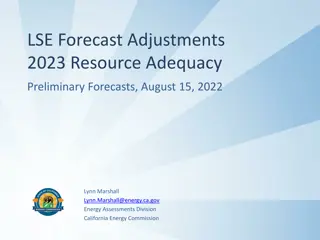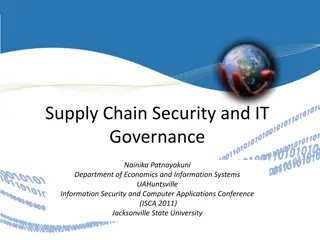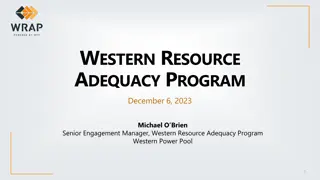Power Supply Resource Adequacy Overview
The Southwest Power Pool is actively addressing resource adequacy challenges to ensure reliable and cost-effective power generation. The backlog mitigation efforts, study durations, and progress reports are essential in maintaining a stable energy supply. The data shows a detailed breakdown of requests in the current queue and the completion status of various phases. By efficiently managing the backlog and studying timelines, the goal is to eliminate delays and ensure a resilient power infrastructure for the future.
Download Presentation

Please find below an Image/Link to download the presentation.
The content on the website is provided AS IS for your information and personal use only. It may not be sold, licensed, or shared on other websites without obtaining consent from the author.If you encounter any issues during the download, it is possible that the publisher has removed the file from their server.
You are allowed to download the files provided on this website for personal or commercial use, subject to the condition that they are used lawfully. All files are the property of their respective owners.
The content on the website is provided AS IS for your information and personal use only. It may not be sold, licensed, or shared on other websites without obtaining consent from the author.
E N D
Presentation Transcript
GI OVERVIEW RESOURCE ADEQUACY SUBGROUP RESOURCE ADEQUACY SUBGROUP JUNE 16, 2023 Working together to responsibly and economically keep the lights on today and in the future. SPPorg southwest-power-pool SouthwestPowerPool
REQUESTS PENDING IN THE CURRENT GI QUEUE Wind 25% Battery/Storage 19% GEN TYPE Requests GW Capacity Battery / Storage 151 22 GW Hybrid 71 14.5 GW Solar 226 48.7 GW Hybrid 12% Thermal 3% Thermal 21 3.6 GW Wind 130 30 GW Solar 41% TOTAL 599 118.8 GW 2
Progress towards eliminating the backlog HOW ARE WE DOING? BACKLOG MITIGATION Active queue began with 898 Requests = 171.5 GW As 3/29/2023: 599 active requests = 118.8 GW 1000 900 32 12 800 Completed 255 700 22 29 32 14 4 1 600 66 149 213 In 500 248 0 Progress 191 0 400 153 13 300 222 247 Requests added in 2022 cluster 259 Not 200 342 313 Started 100 183 98 0 Q2 2022 Q3 2022 Q4 2022 Q1 2023 Not Started DISIS IFS Withdrawn GIA Pending GIA Executed 3
STUDY DURATIONS Avg. Phase 1 delay: 79 days Avg. Phase 2 delay: 38 days Completed Study Duration Overage vs. Tariff Timeline 200 180 160 FBD Begins 140 Days of Overage 120 100 80 60 40 20 0 *Based on final report re-posting date 4
GI BACKLOG MITIGATION MS: DP2 Final Backlog Cluster Study Complete 11/15/24 MS: GI Backlog Mitigation Program Complete 6/5/25 FERC Approval of SPP Filing in ER22-253 (RR458) 2017-002 ILTCR Paths Due 2022 2023 2024 2025 2025 Jan Jul Jan Jul Jan Jul Jan Today 1702 Phase 2 1702 DP2 1702 Restudy 1702 Cluster 1702 FS POI and Network (old tariff) 1702 GIA 1801 Phase 1 1801 DP1 1801 DP2 1801 Cluster 1801 Phase 2 1801 Restudy 1801 FS - POI 1801 FS - Network 1801 GIA 1802, 1901 Phase 1 1802, 1901 DP1 +10BD 1802, 1901 DP2 1802,1901 Restudy 1802, 1901 Phase 2 1802, 1901 Cluster 1802, 1901 FS - Network 1802, 1901 FS - POI 1802, 1901 GIA 2001 Phase 1 2001 DP1 2001 DP2 2001 Phase 2 2001 Restudy 2001 Cluster 2001 FS - POI 2001 FS - Network 2001 GIA 2101 Phase 1 2101 DP1 2101 DP2 2101 Phase 2 2101 Restudy 2101 Cluster 2101 FS-POI 2101 FS - Network 2101 GIA 2201 Phase 1 2201 DP1 2201 DP2 2201 FS-POI 2201 Restudy 2201 FS-Network 2201 GIA 2201 Cluster 2201 Phase 2 5 Restudy based on higher queued withdrawal; information is provided for planning purposes
DISIS 2022 CLUSTER CHALLENGES Dispatch the NR cases High amount of NRIS requests (98% of the capacity) 50+GW of current queue generation to sink 35GW of sinkable generation SPP Staff is analyzing some options to adjust the sinking methodology 6
OVERVIEW OF GI INITIATIVES Continue progress on GI Backlog and eliminate by end of 2024 Implement CRIS and ERIS modifications per HITT T1 Establish a baseline GI Manual to facilitate future enhancements (TWG/GIMTF) Implement new Transmission Hosted Capacity Tool Facilitate stakeholder involvement through conversion of GIUF to GIAG Implement new SPP/MISO Tie line process (Joint-Operating Agreement) Establish Seasonal Limited Operation Interconnection Service Implement JTIQ Process to reduce affected system studies w/MISO Implement SmartQ/AWS to improve intake and model build efficiency Implement Consolidated Planning Process to optimize upgrade selection and better align costs/benefits among all stakeholders GI NOPR 7























